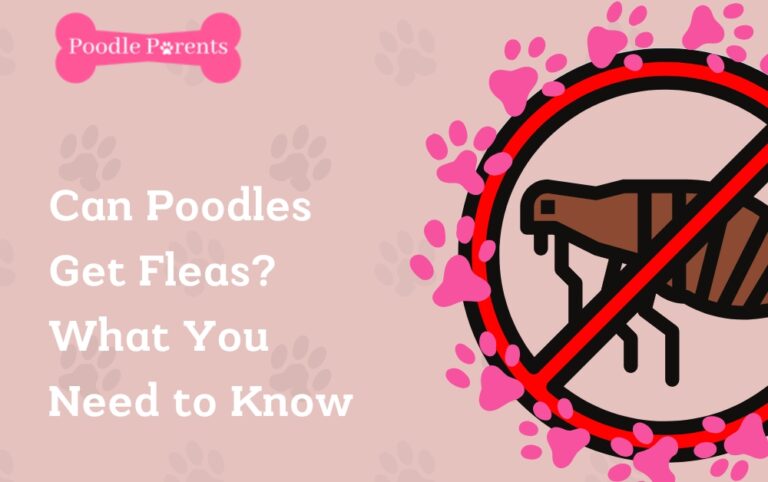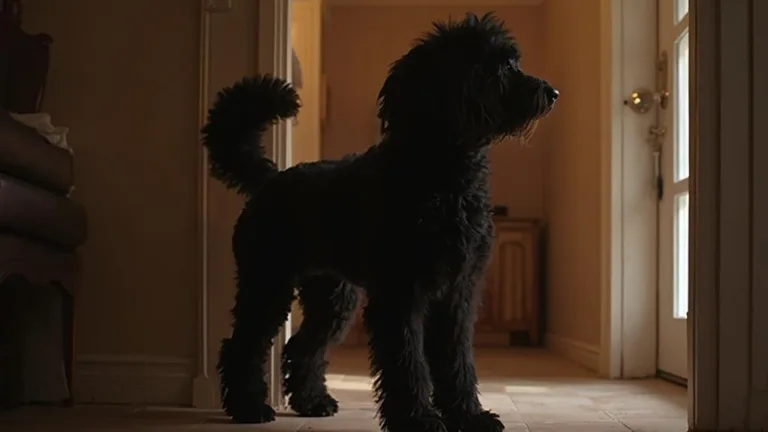Toy Poodle Litter Size: Information About Poodle Pregnancy
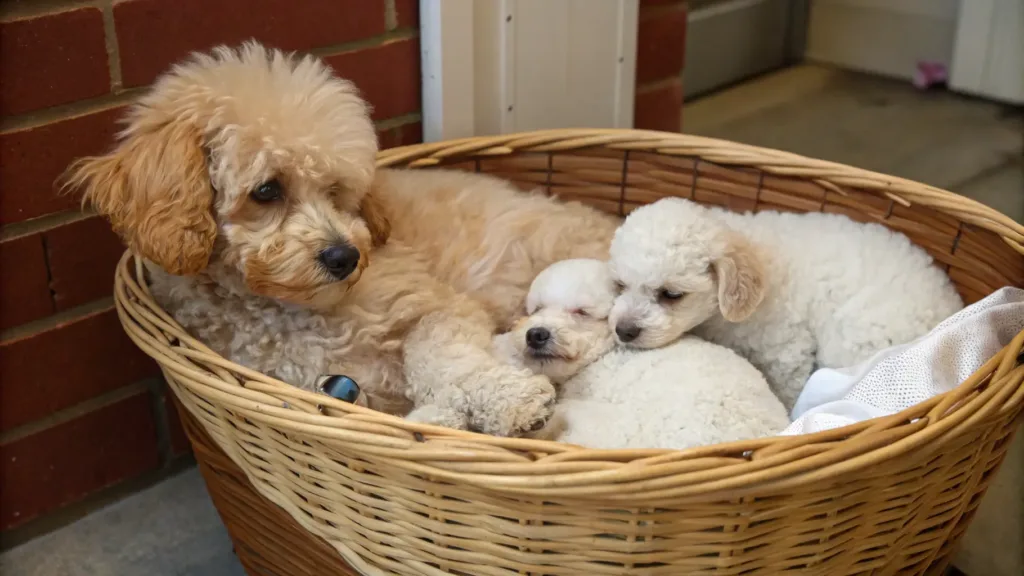
Toy Poodles typically have small litters ranging from 2-4 puppies, with an average of 3 puppies per pregnancy. You’ll notice the first signs of pregnancy within 3 weeks, including mood changes and increased affection.
By weeks 4-6, you can expect enlarged nipples, swelling, and increased appetite. Your pregnant Toy Poodle needs high-quality food with extra protein from sources like eggs and cottage cheese.
During the final weeks, she’ll display nesting behavior and decreased body temperature as labor approaches.
Proper preparation, including a warm whelping box and essential supplies, will help guarantee a successful delivery. There’s much more to learn about caring for your pregnant Toy Poodle.
Understanding Toy Poodle Pregnancy Signs
Most Toy Poodle owners don’t realize their pet is pregnant until several weeks into gestation. Your female dog will initially show subtle changes, including mood swings, increased affection, and mild lethargy during the first three weeks of poodle pregnancy.
By weeks 4-6, you’ll notice more obvious signs that your Toy Poodle is preparing to give birth. Her nipples will become enlarged and pink around day 25, and she’ll begin to show noticeable abdominal swelling.
You’ll also observe an increased appetite and more frequent urination. At this stage, your veterinary provider can perform an ultrasound to confirm pregnancy and check fetal heartbeats.
During the final weeks (7-9), your Toy Poodle’s body will undergo significant changes as she prepares for her upcoming litter size.
Watch for visible puppy movement in her abdomen, enlarged mammary glands producing milk, and nesting behavior. She may gather toys and blankets, show decreased appetite, and have clear vaginal discharge.
When her body temperature drops below 100°F, labor typically begins within 24 hours. Monitor these signs closely and maintain regular veterinary check-ups throughout the pregnancy.
Average Litter Size
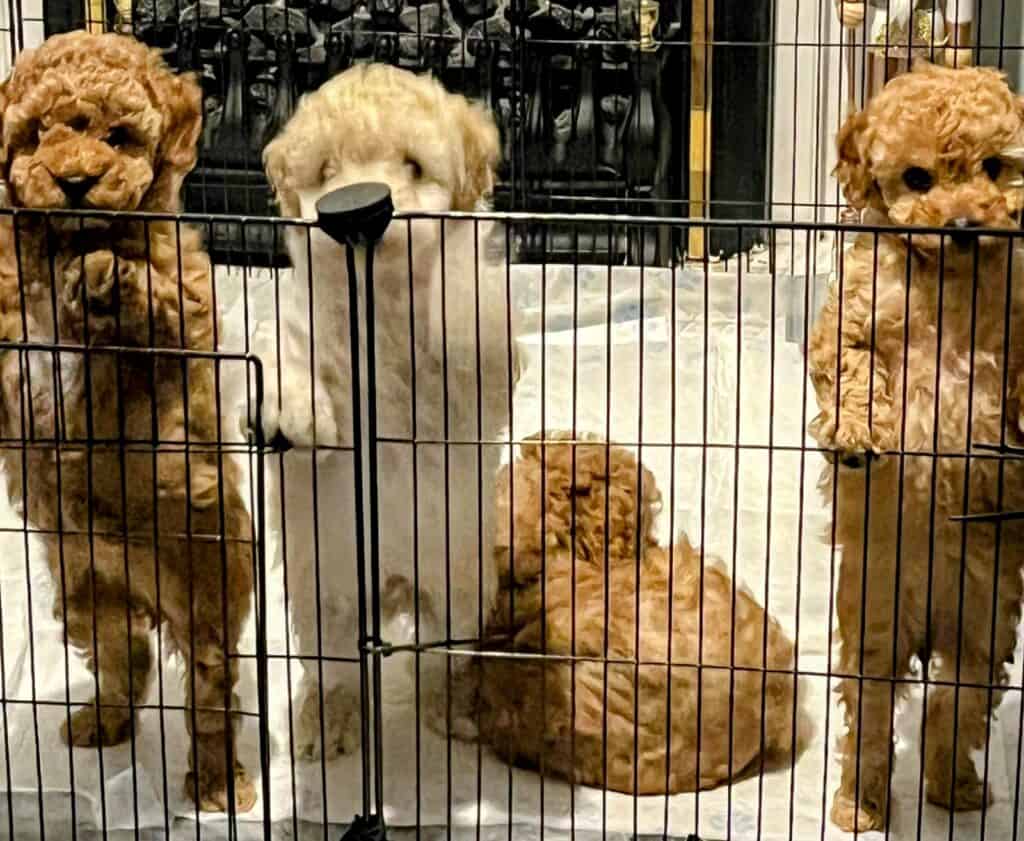
When planning for your Toy Poodle’s pregnancy, understanding potential litter size helps you prepare appropriate resources and care. As a smaller breed, Toy Poodles typically have fewer puppies compared to larger dogs, with an average litter size of three puppies.
You’ll want to be prepared for singleton litters, which are relatively common in Toy Poodles. While the litter size range can extend up to five puppies, this is quite rare. Most litters contain between two to four puppies, though some sources report an even smaller average of 2.4 puppies per litter.
Several factors influence how many puppies your Toy Poodle might have. The age of mother plays a significant role, with older females generally producing smaller litters. Other important variables include genetic factors, the mother’s overall health condition, and the timing of breeding.
You’ll want to discuss these factors with your veterinarian to better comprehend what to expect from your specific dog’s pregnancy.
This knowledge will help you prepare appropriate whelping supplies and guarantee you’re ready for any scenario, whether it’s a single puppy or a larger litter.
Preparing To Give Birth

Setting up a proper whelping area stands as your first imperative task when preparing for your Toy Poodle’s delivery.
You’ll need to create a whelping box in a quiet location, ensuring it’s sized appropriately for your small breed while maintaining a consistent temperature of 85°F for the first week after birth.
Monitor your Toy Poodle’s temperature twice daily as her due date approaches. When it drops below 100°F, labor typically begins within 24 hours. Watch for signs of labor including restlessness, pacing, shivering, and nesting behavior.
Given the typical small litter size of 1-5 puppies, you’ll want to be especially vigilant during the birthing process.
Gather essential supplies beforehand: clean towels, sterilized scissors, unwaxed dental floss, iodine, and a heating pad. Keep your veterinarian’s contact information readily available, as Toy Poodles may require veterinary assistance due to their small size.
Record birth times and puppy details in a notebook during delivery. Since whelping can last several hours, prepare to stay with your dog throughout the entire process, ensuring she’s constant access to fresh water.
Labor and Delivery Process
Throughout the labor process, your Toy Poodle will experience three distinct stages, starting with a noticeable drop in body temperature below 100°F.
During Stage I, which typically lasts 6-12 hours, you’ll notice your poodle becoming restless, refusing food, and exhibiting nesting behavior. If this stage exceeds 24 hours without progression, contact your veterinarian immediately.
Stage II marks the active delivery of puppies, with visible abdominal contractions. Given the smaller litter size typical for the Toy Poodle breed, expect between 1-5 puppies.
Each puppy should arrive within 1-2 hours of strong contractions, though there may be resting phases of up to 4 hours between deliveries. Stage III involves placenta delivery, occurring 5-15 minutes after each puppy.
Monitor for strong contractions lasting more than 30 minutes without producing a puppy
Watch for excessive bleeding or foul-smelling discharge
Guarantee each puppy starts nursing within a few hours of birth
Count placentas to confirm they match the number of puppies delivered
Keep your veterinarian’s contact information readily available for emergencies
As Toy Poodles can be prone to delivery complications due to their size, always be prepared to seek immediate veterinary assistance if needed.
Maternal Health During Pregnancy

A healthy mother Poodle lays the foundation for strong, thriving puppies. During pregnancy, you’ll need to focus on several key aspects of maternal care to guarantee the best outcomes for both mom and her future litter.
Proper nutrition becomes imperative as your pregnant Poodle’s needs change. You should provide high-quality dog food specifically made for pregnant dogs, increasing her calorie intake by up to 50% from week five onwards.
Add an egg daily and some cottage cheese for extra protein, but avoid calcium supplements which can cause eclampsia.
Exercise should remain moderate, with daily walks to maintain muscle tone, but avoid strenuous activities. Your veterinary care schedule will include regular check-ups, with an ultrasound around day 28 and an X-ray after day 45 to count puppies.
Careful monitoring of weight gain and temperature is necessary, especially in the week before delivery. Take her temperature twice daily – a drop below 100°F signals approaching labor.
Environmental considerations play a pivotal role too. Create a stress-free setting and prepare a quiet whelping area well in advance. Maintain strict hygiene to prevent infections and provide your Poodle with plenty of opportunities to rest.
Puppy Development After Birth
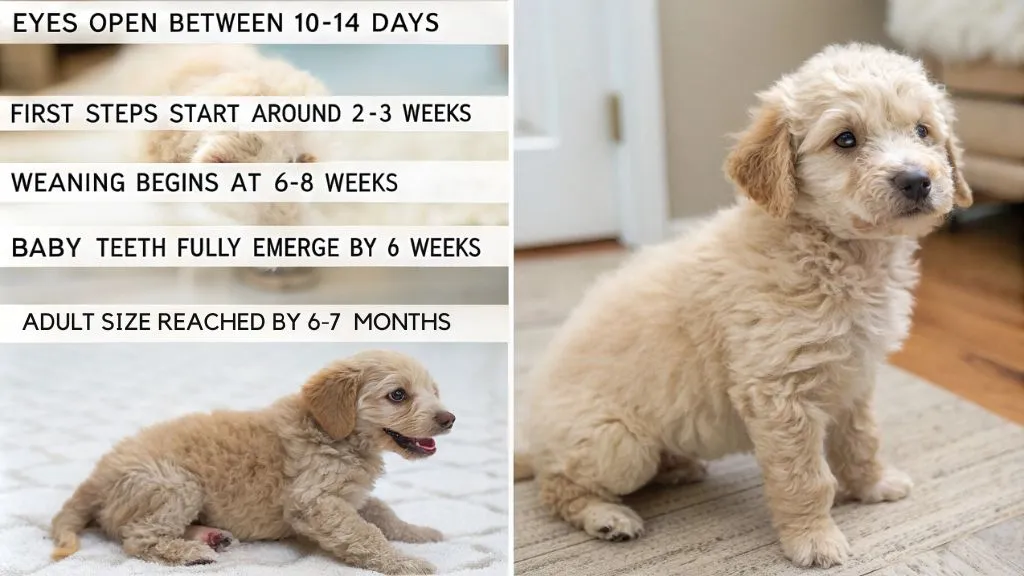
Watching newborn Toy Poodle puppies develop brings constant surprises as they progress through distinct growth stages. During the neonatal period (0-2 weeks), your puppies will sleep extensively and depend entirely on their mother for warmth and nutrition.
The shift period follows at 2-3 weeks, when they’ll open their eyes and take their first wobbly steps.
The socialization period (3-12 weeks) marks rapid development, as your puppies begin exploring and playing with littermates. You’ll need to monitor them closely for hypoglycemia, which is common in toy breeds.
During growth and development, you’ll see their adult teeth emerge around 4-5 months, with full size typically reached by 6-7 months.
- Eyes open between 10-14 days
- First steps start around 2-3 weeks
- Weaning begins at 6-8 weeks
- Baby teeth fully emerge by 6 weeks
- Adult size reached by 6-7 months
Regular veterinary check-ups are essential to maintain proper development. While these timelines serve as guidelines, remember that each puppy develops at their own pace, reaching mental maturity around one year of age.
Breeding Age and Timing

Responsible Toy Poodle breeders know that timing is essential for successful breeding. Your female poodle should be at least 18 months to 2 years old before her first breeding, even if she’s experienced earlier heat cycles.
For male poodles, the appropriate age also falls between 18-24 months to ascertain proper physical maturity.
You’ll want to monitor your female poodle’s heat cycle, which occurs roughly twice a year. This cycle determines when she’s capable of becoming pregnant. However, just because she can breed doesn’t mean she should.
It’s pivotal to limit breeding frequency to protect your dog’s well-being. Most experts recommend breeding a female Toy Poodle only once per year, with a maximum of two litters in her lifetime.
Female Toy Poodles can typically breed until they’re 7 years old, while male poodles should retire from breeding around 6-6.5 years.
When planning breeding, confirm both parents are of similar age and have undergone proper health testing. Always consult your veterinarian before breeding to validate your poodle’s health status and readiness for reproduction.
Conclusion
As you watch your Toy Poodle lovingly nest in her whelping box, you’ll marvel at nature’s perfect timing. Your tiny mother-to-be will cradle her precious 2-3 puppies, each no bigger than your palm at birth.
You’re now equipped with essential knowledge to guide her through pregnancy, from those first telltale signs to the joyful moment when you’ll hear tiny paws pattering across your floor.
FAQ
The average litter size in dogs, particularly for Toy Poodles, typically ranges from 2 to 4 puppies.
However, it is not uncommon for a Toy Poodle to have a larger litter of puppies, sometimes reaching up to 6 puppies. The size of a litter can be influenced by factors such as the dog’s health, age, and genetics.
The litter size in dogs can vary significantly between different varieties of Poodles. For instance, standard poodles may average a larger litter size, ranging from 4 to 8 puppies, while miniature poodles often have 4 to 6 puppies.
In contrast, Toy Poodles, being the smallest variant, generally have smaller litters, averaging 2 to 4 puppies.
Potential litter size of a Toy Poodle. The age and health of the mother dog play crucial roles.
Younger dogs and those in good health tend to have larger litters. Additionally, the female’s reproductive tract must be in optimal condition for successful breeding. Genetic factors also contribute, as some bloodlines may naturally produce larger or smaller litters.
Litter size for a Toy Poodle can reach up to 8 puppies in a single litter of puppies. While this is not the norm, extraordinary cases exist and are often documented by breeders.
Most litters are smaller, but exceptional circumstances can lead to larger numbers.



